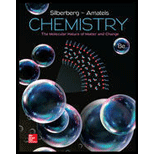
(a)
Interpretation:
The element and its condensed ground state electronic configuration with excited state electronic configuration
Concept introduction:
The electronic configuration tells about the distribution of electrons in various atomic orbital. The condensed electronic configuration is a way to write the electronic configuration where the inner shell configurations are compressed to the nearest noble gas configuration and only the valence shell configuration is written in the expanded form.
The lower stable energy level is known as the ground state whereas the higher unstable energy level is called the excited state. Elements in the excited state have much tendency to lose energy and come back to the ground state.
(a)
Answer to Problem 8.44P
The element with the excited state electronic configuration
Explanation of Solution
The excited state electronic configuration of the given element is
The given element is magnesium and its condensed ground state electronic configuration is
(b)
Interpretation:
The element and its condensed ground state electronic configuration with excited state electronic configuration
Concept introduction:
The electronic configuration tells about the distribution of electrons in various atomic orbital. The condensed electronic configuration is a way to write the electronic configuration where the inner shell configurations are compressed to the nearest noble gas configuration and only the valence shell configuration is written in the expanded form.
The lower stable energy level is known as the ground state whereas the higher unstable energy level is called the excited state. Elements in the excited state have much tendency to lose energy and come back to the ground state.
(b)
Answer to Problem 8.44P
The element with the excited state electronic configuration
Explanation of Solution
The excited state electronic configuration of the given element is
The given element is chlorine and its condensed ground state electronic configuration is
(c)
Interpretation:
The element and its condensed ground state electronic configuration with excited state electronic configuration
Concept introduction:
The electronic configuration tells about the distribution of electrons in various atomic orbital. The condensed electronic configuration is a way to write the electronic configuration where the inner shell configurations are compressed to the nearest noble gas configuration and only the valence shell configuration is written in the expanded form.
The lower stable energy level is known as the ground state whereas the higher unstable energy level is called the excited state. Elements in the excited state have much tendency to lose energy and come back to the ground state.
(c)
Answer to Problem 8.44P
The element with the excited state electronic configuration
Explanation of Solution
The excited state electronic configuration of the given element is
The given element is manganese and its condensed ground state electronic configuration is
(d)
Interpretation:
The element and its condensed ground state electronic configuration with excited state electronic configuration
Concept introduction:
The electronic configuration tells about the distribution of electrons in various atomic orbital. The condensed electronic configuration is a way to write the electronic configuration where the inner shell configurations are compressed to the nearest noble gas configuration and only the valence shell configuration is written in the expanded form.
The lower stable energy level is known as the ground state whereas the higher unstable energy level is called the excited state. Elements in the excited state have much tendency to lose energy and come back to the ground state.
(d)
Answer to Problem 8.44P
The element with the excited state electronic configuration
Explanation of Solution
The excited state electronic configuration of the given element is
The given element is neon and its condensed ground state electronic configuration is
Want to see more full solutions like this?
Chapter 8 Solutions
Chemistry: The Molecular Nature of Matter and Change
- Identify any polar covalent bonds in epichlorohydrin with S+ and 8- symbols in the appropriate locations. Choose the correct answer below. Η H's+ 6Η Η Η Η Η Ηδ Η Ο Ο HH +Η Η +Η Η Η -8+ CIarrow_forwardH H:O::::H H H HH H::O:D:D:H HH HH H:O:D:D:H .. HH H:O:D:D:H H H Select the correct Lewis dot structure for the following compound: CH3CH2OHarrow_forwardRank the following compounds in order of decreasing boiling point. ннннн -С-С-Н . н-с- ННННН H ΗΤΗ НННН TTTĪ н-с-с-с-с-о-н НННН НН C' Н н-с-с-с-с-н НН || Ш НННН H-C-C-C-C-N-H ННННН IVarrow_forward
- Rank the following compounds in order of decreasing dipole moment. |>||>||| ||>|||>| |>|||>|| |||>||>| O ||>>||| H F H F H c=c || H c=c F F IIIarrow_forwardchoose the description that best describes the geometry for the following charged species ch3-arrow_forwardWhy isn't the ketone in this compound converted to an acetal or hemiacetal by the alcohol and acid?arrow_forward
- What is the approximate bond angle around the nitrogen atom? HNH H Harrow_forwardOH 1. NaOCH2CH3 Q 2. CH3CH2Br (1 equiv) H3O+ Select to Draw 1. NaOCH2 CH3 2. CH3Br (1 equiv) heat Select to Edit Select to Drawarrow_forwardComplete and balance the following half-reaction in acidic solution. Be sure to include the proper phases for all species within the reaction. S₂O₃²⁻(aq) → S₄O₆²⁻(aq)arrow_forward
- Q Select to Edit NH3 (CH3)2CHCI (1 equiv) AICI 3 Select to Draw cat. H2SO4 SO3 (1 equiv) HO SOCl2 pyridine Select to Edit >arrow_forwardComplete and balance the following half-reaction in basic solution. Be sure to include the proper phases for all species within the reaction. Zn(s) → Zn(OH)₄²⁻(aq)arrow_forwardb. ὋΗ CH3CH2OH H2SO4arrow_forward
 ChemistryChemistryISBN:9781305957404Author:Steven S. Zumdahl, Susan A. Zumdahl, Donald J. DeCostePublisher:Cengage Learning
ChemistryChemistryISBN:9781305957404Author:Steven S. Zumdahl, Susan A. Zumdahl, Donald J. DeCostePublisher:Cengage Learning ChemistryChemistryISBN:9781259911156Author:Raymond Chang Dr., Jason Overby ProfessorPublisher:McGraw-Hill Education
ChemistryChemistryISBN:9781259911156Author:Raymond Chang Dr., Jason Overby ProfessorPublisher:McGraw-Hill Education Principles of Instrumental AnalysisChemistryISBN:9781305577213Author:Douglas A. Skoog, F. James Holler, Stanley R. CrouchPublisher:Cengage Learning
Principles of Instrumental AnalysisChemistryISBN:9781305577213Author:Douglas A. Skoog, F. James Holler, Stanley R. CrouchPublisher:Cengage Learning Organic ChemistryChemistryISBN:9780078021558Author:Janice Gorzynski Smith Dr.Publisher:McGraw-Hill Education
Organic ChemistryChemistryISBN:9780078021558Author:Janice Gorzynski Smith Dr.Publisher:McGraw-Hill Education Chemistry: Principles and ReactionsChemistryISBN:9781305079373Author:William L. Masterton, Cecile N. HurleyPublisher:Cengage Learning
Chemistry: Principles and ReactionsChemistryISBN:9781305079373Author:William L. Masterton, Cecile N. HurleyPublisher:Cengage Learning Elementary Principles of Chemical Processes, Bind...ChemistryISBN:9781118431221Author:Richard M. Felder, Ronald W. Rousseau, Lisa G. BullardPublisher:WILEY
Elementary Principles of Chemical Processes, Bind...ChemistryISBN:9781118431221Author:Richard M. Felder, Ronald W. Rousseau, Lisa G. BullardPublisher:WILEY





